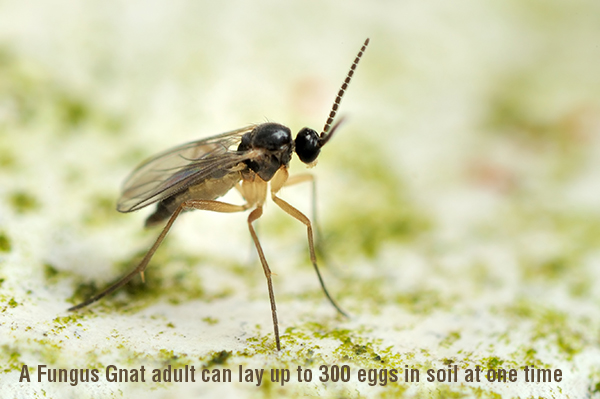Controlling Fungus Gnats
How to control Fungus GnatsEver wondered what those tiny black flying insects are buzzing about in small groups around your indoor plants? Fungus gnats (Sciaroidea family) in their adult form can be most annoying invading our interior space in large numbers. But it is their larvae which do the most damage to plants’ roots. Adult flies lay hundreds of eggs at a time in the plants’ soil and their eggs hatch into white worms-like larvae featuring black heads, wreaking havoc by feeding on the roots and soft stem material of the plant, seriously weakening its ability to survive. The Fungus Gnat’s life cycle from egg to adult flies is just three weeks.
Fungus gnats and other similar in appearance flying insects are attracted to moist soil which is rich in organic composted matter, such as in high-quality potting mixes. This is a little unfortunate for plant lovers, as healthy growing plants need this composted matter to flourish. Thankfully, striking a balance with nature is possible with a few simple rules.
Firstly, to detect larvae presence, gently dig around the soil for evidence of the worm-like creature. They can also leave a silvery shiny trail on the top layer of the potting mix, similar to snails and slugs.
Tips for controlling Fungus Gnats• Fungus Gnats love moist wet soil where they can thrive in great numbers. So be careful not to overwater pot plants and let the soil dry out between watering. This will greatly reduce the numbers of eggs hatching and larvae feasting.
• Stop their life cycle by hanging sheets of sticky traps close to the indoor plants to kill the adults before they have a chance to lay their eggs in the soil.
• A physical barrier can also be created to prevent adults from accessing the soil to lay their eggs. Mulch thickly over the top layer of soil with stones, gravel and small pebbles.
• In small numbers, they are not a cause for concern. In severe cases, to control larvae and stop eggs from hatching in the soil, treat them with an approved insecticide.
• To reduce the number of adult flying gnats, use a household surface spray around the area of the plants but don't spray directly on the plant's foliage.
It is worth noting during composting of our potting mix products, the high temperatures reached during the process make the mixes a very inhospitable environment for insects, eggs or larvae. It is simply too hot for them. Once the mix is in the bag though, the necessary breather holes in the bags, or the opened partially used bag, can allow pests access to the mix. Minimising the time potting mix is stored and storing the bags correctly in a sealed container indoors, is the best way to prevent pest problems occurring.
|






